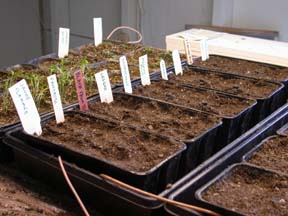|
Starting from seedby AMY STEWART
To make matters worse, I agreed once again to participate in seed trials for Organic Gardening magazine. Thirty seed packets arrived by mail from their office in Pennsylvania, each containing either a new hybrid seed that would not be available commercially until 2004, or a newly reintroduced heirloom that has only just now been grown in sufficient quantities for wholesale distribution. It's fun to try out new varieties, but sometimes it can be a strain on my garden. One year I grew nearly 20 tomato plants and a dozen peppers. This year there are five varieties of watermelon (that is, if you include something called a cuca-melon, which is, according to the package, shaped like a tiny watermelon but tastes like a cucumber) and five varieties of beans. These are all heat-loving crops; they are doomed to failure in my foggy garden. I do my best to explain this to the folks back in Pennsylvania, but when they think about California, they imagine sun and warmth. So I get the same seeds that testers in other parts of the country get, and we all do our best. If you've never grown your own flowers and vegetables from seed, maybe this is the year to give it a try. A seed table bursting with tiny green seedlings is surely one of the great joys of spring, providing solid comfort on those unexpectedly windy, rainy days in April and May. Here are a few suggestions to get you started: The Setup: I use an old kitchen table covered in a plastic dropcloth. A card table or a workbench works just fine. Try to choose a warm spot for them; seeds simply won't germinate and grow in a chilly basement. I use a heated electric cable under my seeds to keep the soil warm; for a little more money, you can also buy a heated mat to place under your seedlings. Light: For years I started seeds in a sunny, screened-in porch. They got plenty of direct sunlight and I never needed to add any artificial light. Now that I start seeds in the attic, I use three shop lights spaced just six inches apart. You can get these at the hardware store, but don't waste your money on special grow lights -- a combination of ordinary warm and cool fluorescent tubes works just fine. I hang my lights from chains so I can easily adjust the height of the lights as the plants grow: they should always be about two inches above the seedlings' top leaves. Put your lights on a timer and give them about 14 hours of light per day. Containers: You can buy seed trays without holes at the nursery, or use old cookie sheets with a low rim, and place the containers inside them to catch the water. I recycle jumbo six-pack containers from the nursery, but yogurt containers, milk cartons, and peat pots are also good options. Dirt: Use a soilless planting medium to prevent disease and ensure that the seeds will germinate easily. I used Whitney Farm's seed-starting mix for years, but lately I've switched to Foxfarm's Light Warrior because it contains worm castings and a special root stimulant. Seed-starting mixes are more expensive than regular potting soil, but they stay damp longer and provide a more hospitable environment for young roots. Water: Instead of pouring water directly over your seedlings, just fill up the tray they're standing in and let the water soak up through the drainage holes in the bottom of the containers. A layer of plastic wrap on top, or a molded plastic seed tray lid, sold at nurseries, will keep moisture in. You can also keep a spray bottle on hand and mist the seed trays, especially when seeds are just starting to germinate. Food: Once your seedlings get to be an inch or two tall, they will appreciate a weak solution of liquid fertilizer to prevent disease and get them growing faster. Seaweed and fish emulsion fertilizers are good organic options. Seeds: There are some plants that just aren't worth growing from seed. Perennial shrubs like lavender and salvia take too long to germinate. You're better off purchasing them directly from the nursery or farmers' market. Flowers like cosmos and sweet pea germinate easily outdoors; there's no reason to take up precious space on your seed table with them. Radishes, carrots, and poppies all put down long, tapered roots that resist transplanting, so they should be sown directly as well. What's most important, though, is that you choose plants that you love, and varieties you can't get at the nursery. This year I'm growing heirloom pumpkins, unusual deep red sunflowers, and -- thanks to my seed trial gig -- about five more varieties of watermelon than I really need. It's a dirty job, but somebody's got to do it.
E-mail garden-related announcements and news to Amy Stewart. IN THE NEWS | COVER STORY | GOOD NEWS | CALENDAR © Copyright 2003, North Coast Journal, Inc. |


 I'M
LATE WITH MY SEEDS THIS YEAR, THE LATEST I'VE ever been. Usually
I get my summer vegetables and flowers started under grow lights
in February, sometimes even January. But this year I was late
with everything: I didn't get my seed orders placed until after
the holidays, they didn't arrive until a few weeks ago, and I
have not yet made a plan of the garden so I can figure out how
many seeds to start.
I'M
LATE WITH MY SEEDS THIS YEAR, THE LATEST I'VE ever been. Usually
I get my summer vegetables and flowers started under grow lights
in February, sometimes even January. But this year I was late
with everything: I didn't get my seed orders placed until after
the holidays, they didn't arrive until a few weeks ago, and I
have not yet made a plan of the garden so I can figure out how
many seeds to start.